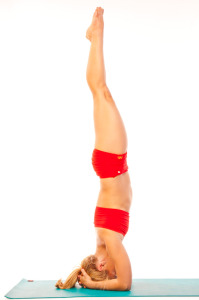Confessions of a headstand
by Nancy B. Loughlin
Published in News Press on November 25, 2014. Posted with permission.
What’s true on the mat is true in life, the yogic adage goes.
I was reminded of this when I attended Kino MacGregor’s headstand workshop at the recent Yoga Journal Conference in Hollywood, FL. Kino is an internationally renowned Ashtanga Yoga teacher based in Miami.
Ashtanga classes intimidate me. The advanced poses, in their full expressions, typify “tricked-out” – legs wrapped around the head, sitting in full lotus with your butt off the floor while balancing on two hands, holding handstand with both feet touching the back of the head. Check out Kino’s Instagram. She looks like a contortionist. And a gymnast.
But when I saw the listing for her headstand workshop, I signed up. Why? Because I can do a headstand. (Ego Alert #1)
Kino began the workshop with the tale of her personal headstand journey. It was a painful process that included kicking her teacher in the chest and punching a hole in her apartment’s drywall. After ten months of trying and falling, she could balance upside-down.
I’ve been able to do a headstand since I was a kid. I smirked. (Ego Alert #2)
Kino explained that a proper headstand begins with activating the shoulder girdle. To get a sense of what this feels like, straighten your arms in front of you so they are parallel to the floor, palms facing each other. Bend the elbows to 90 degrees, fingertips to the sky. Now squeeze your elbows together in front of you so they are almost touching, your arms in a V.
In basic headstand, you aren’t balancing on your head but building a base with your forearms so the shoulder girdle can support the body, not your back or neck. This shoulder-supported inversion creates a clear passageway for the awakened energy of the body and spirit that comes from an inversion of perspective. With this proper alignment, that energy can flow without obstruction or interference along the spine to the crown.
Thus, Kino explained, once you have headstand, you should hold it for three minutes in daily enlightenment practice.
For headstand prep: Get on your hands and knees with your palms directly under your shoulders. Then, lower your forearms to the floor. Bring your palms to touch and interlace your fingers. Drop your crown to the floor in the cradle of your hands. Activate the shoulder girdle by pushing your elbows and forearms into the floor. Remember the sensation of the V.
Then, straighten your legs and push up onto your toes.
From there, you pull your knees into your chest and hold. When steady, you straighten your legs to the sky.
During the workshop, this did not happen. My toes didn’t leave the ground. My shoulders and upper back were on fire, and I was stuck in headstand prep.
Kino sensed that some of us were in trouble. She told us to hold the prep with our shoulders activated, toes on the floor. I was disobedient and spied on everyone else. Kino sauntered over with a smile, “What’s going on?”
I bit my lip and went back to prep. And I stayed there for the rest of the class. (Ego deflated.)
Afterward, I asked Kino why this was so difficult for me, and we discovered that when I do headstand, I kick up with core strength and momentum which isn’t so bad. But then, I collapse into my lower back. That’s bad.
Before I should return to headstand practice, I need to strengthen the apparatus that will support me. Then, I’ll be able to do more than a headstand.
I’ve been practicing Kino’s headstand preps, and I’ve been meditating on what all this meant. Headstand is a dream pose for so many yogis. It’s a mountain of achievement and a great photo. Throughout my life, I’ve accomplished flashy deeds that make great pictures, both literal and metaphorical. Yet, I’ve done so by overworking myself, throwing more onto my back than I should. Yes, the results may have had temporary value, but the process has been whittling away my strength and my potential for achieving more.
I have been breaking my own back, on and off the mat.
Visit Kino’s website: www.KinoYoga.com. Click on the videos to view her headstand prep tutorial.
Nancy B. Loughlin is a writer and yogi in Ft. Myers. She can be reached at [email protected] or Twitter @NancyLoughlin

